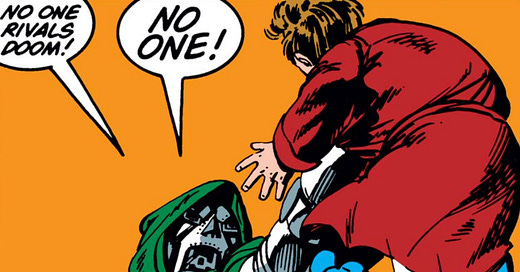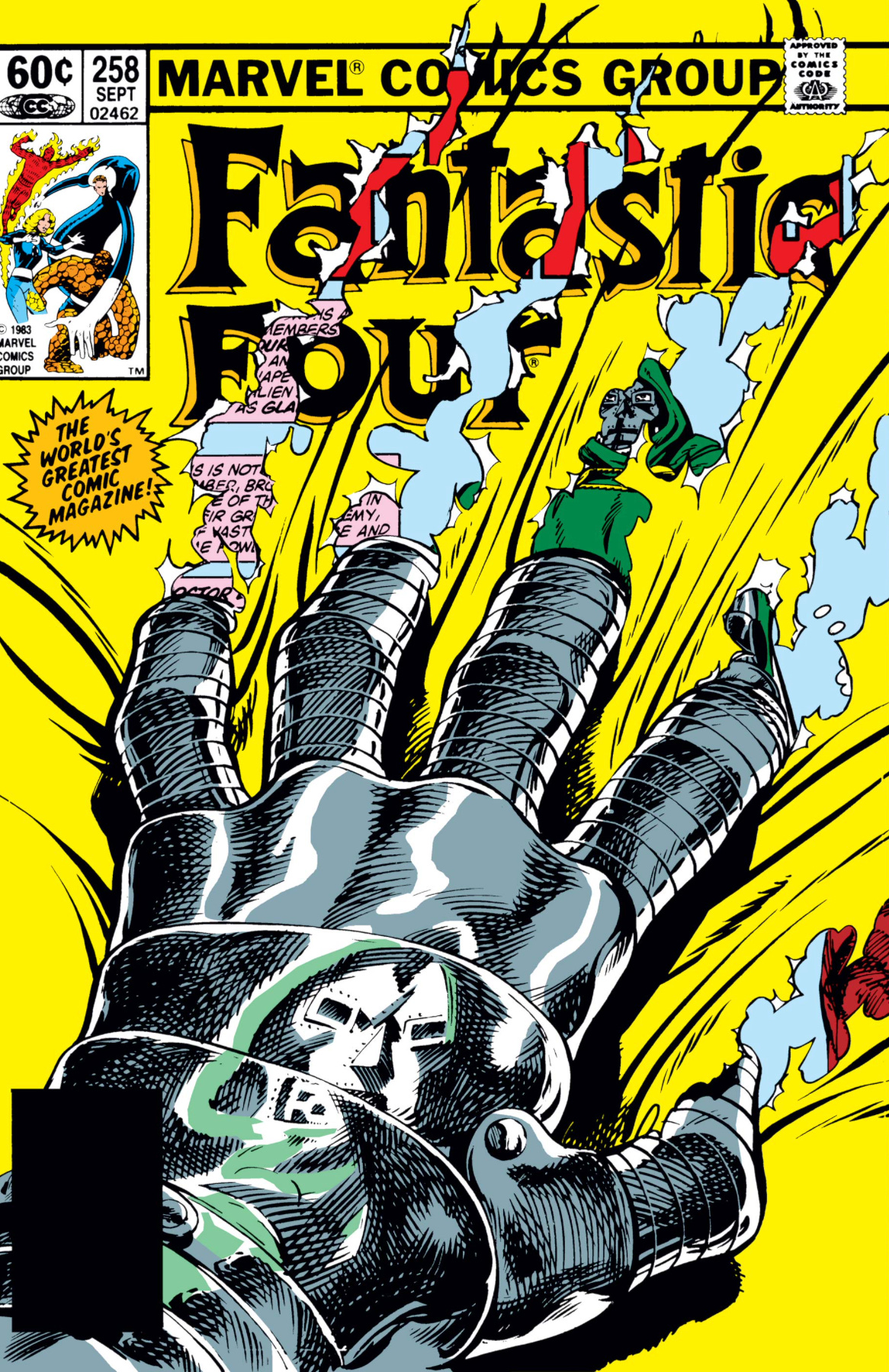Previously … I ranked the best of 1961-65, 1966-70, 1971-75, and 1976-80.
This was an excellent half-decade of comics. Choosing 10 favorites was not easy, and if I looked at this again a year from now, I might choose some different comics in a different order. In the comments, please point out all the wonderful comics that aren’t listed.
(Storylines are getting longer in this era, so those that spanned 1985-86 qualify for this list only if the majority of the issues came out in 1985. Daredevil’s “Born Again” storyline will qualify for 1986-90, for example.)
10) Fantastic Four #236 (by John Byrne)
The Fantastic Four get to experience the road not taken as Doctor Doom concocts the perfect trap for his enemies. With the aid of the Puppet Master, he imprisons them in tiny clone bodies in an idyllic, miniature town. They have no memories of their real lives, just strange dreams that keep haunting them.
And, of course, Doom can’t resist occasionally popping in and playing the role of Reed’s boss. It’s not enough to strand Mr. Fantastic in a model town; no, Doom needs to psychologically dominate his most hated enemy by repeatedly making him feel like an idiot. It’s very much in character.
To escape, the Fantastic Four must leave peace and tranquility, and in choosing to do so, they demonstrate their heroic essence.
9) The Death of Captain Marvel (by Jim Starlin)
This graphic novel isn’t simply a story that leads up to Captain Marvel’s death—it’s about the process of death. Captain Marvel is dying of cancer. A superhero who’s prevailed over countless fantastic threats is being slowly killed from within.
It’s a poignant end for this version of Captain Marvel, who had previously transcended into more advanced states of being, symbolizing the best a person could be. He had grown significantly since his introduction over a decade earlier, but now, as a consequence of a routine heroic action, he recedes into a tragic state of decay. His most brilliant superhero allies struggle to devise a cure, but not even they can defeat cancer.
The end is especially fitting. We’re taken inside Captain Marvel’s head as he imagines one final battle with his deceased archenemy Thanos. Captain Marvel fights for his life while Thanos tries to convince him to accept the inevitable.
8) The New Mutants Special Edition #1, The Uncanny X-Men Annual #9 (by Chris Claremont and Arthur Adams)
Mixing X-Men and Asgard shouldn’t work, and yet somehow it does.
The first part is especially wonderful. The New Mutants were never meant to be traditional superheroes. They’re students first and foremost, young teenagers who are learning to control their powers in a world that fears and hates them. So, this story scatters them across an entirely different world.
Each individual New Mutant spends time in the spotlight as they get separated in the varied regions of this mythical Norse realm, each encountering different sorts of beings and creatures. Some of the kids initially enjoy the experience and even find Asgard preferable to Earth. For others, it’s not nearly so wonderful. In all cases, strong characterization drives everything. It’s hardly a superhero story—it’s a fantasy adventure, and that fits the X-Men’s junior team nicely indeed.
7) Fantastic Four #258 (by John Byrne)
The Fantastic Four don’t appear in this issue. This is Doom’s book, and he carries it so well that you don’t even notice the absence of the title characters. While the issue sets the stage for the FF’s next threat, it spends ample time showing us a day in the life of Doctor Doom—how he rules over the country Latveria, sincerely believing himself to be a benevolent dictator to his people; how, in his own twisted way, he seems to genuinely care for his young ward Kristoff, even allowing the child to stand by his side as he tends to his monarchial duties; how he maintains constant awareness of people who plot against him; and how enraged he becomes if anyone or anything dares to question his supremacy.
Without ever explicitly telling us so, Byrne portrays Doom as a man who’s living in a constant state of fear. It never looks like fear, though; it looks like ego, suspicion, rage, and a desire to control or destroy all enemies. Doom has lots of power and resources, but no real human connections to draw strength from. And holding onto power, without support, takes considerable and constant effort. One slip-up, and it could all be gone—and he’d have nothing.
This issue shows us why Doom is the perfect foil to Marvel’s premier family (even if that family is taking the issue off).
6) The Uncanny X-Men #185-186 (by Chris Claremont, John Romita Jr., and Barry Windsor-Smith)
Storm loses her powers in this storyline, but instead of being immediately reversed, it precipitates character growth. More than most X-Men, Storm’s powers affect her personality, often requiring her to repress her emotions because of how she might affect the weather around her. She was already beginning to change and grow, but this pushes her further into new territory. Losing her connection to nature is like going blind, and she no longer has an excuse for her extreme stoicism. She suffers this loss as a result of a heroic action—taking a shot meant for Rogue, who probably wouldn’t have minded nearly as much.
Forge is at his most interesting here. He represents a more extreme form of Storm’s emotional withdrawal. An attraction develops between the two, and the fact that he invented the device that erased her powers adds tension and subtext.
We also get to see how much Rogue has grown during her short time with the X-Men. Great character work all around.
5) The Amazing Spider-Man #229-230 (by Roger Stern and John Romita Jr.)
Spider-Man works best as the underdog. Against the unstoppable Juggernaut, he’s very much the underdog.
Juggernaut pursues the psychic Madame Web, and only Spider-Man is available to come to her aid. But he’s totally ineffectual against an invulnerable opponent who’s as strong as the Hulk. He seeks help from other superheroes, but they’re all out of town (conveniently for the story, inconveniently for Spidey). It’s all on him. He tries. He fails.
But for Spidey, failure is motivation. Someone was counting on him, and he let her down. That hits hard, especially given his previous failures. So he picks himself back up and resolves to stop the Juggernaut, no matter the personal cost, and issue #230 shows Spider-Man giving it all he’s got until he prevails.
4) Daredevil #170-172 (by Frank Miller)
The rebirth of the Kingpin. At the start, Wilson Fisk is happily retired from his life of crime, but crime needs him. So, criminals target his wife to lure him back into the game. He loses the only person he loves, and all those brilliant criminal instincts resurface and bury his humanity.
These three issues don’t just establish the Kingpin as a prominent Daredevil villain—they show why he’s the perfect Daredevil villain. Whereas Daredevil loves the law as an avenue for justice, Kingpin perverts the law for personal gain.
Bullseye also returns. Daredevil had just saved his life recently, so every person Bullseye kills weighs heavily on Matt’s conscience, foreshadowing events to come. Frank Miller is just getting warmed up as writer/artist, and he’s already hitting Daredevil hard.
3) Wolverine #1-4 (by Chris Claremont and Frank Miller)
A good rule for a spin-off is to place one familiar character in an unfamiliar setting with unfamiliar characters. That’s basically what we get here. The result is something that feels like a Wolverine story, not an X-Men story starring only Wolverine. It builds on what’s already been established and creates something new.
Wolverine’s internal tension drives the story as much as external forces do, as his bestial impulses conflict with his desire to become a man worthy of Mariko’s love. It’s the quintessential Wolverine story, with a strong character arc throughout.
The miniseries features some of Chris Claremont’s strongest writing and some of Frank Miller’s strongest art. The two bring out the best in each other as they show Wolverine striving to be his best—and stumbling quite a bit along the way.
2) The Uncanny X-Men #172-173 (by Chris Claremont and Paul Smith)
This two-parter weaves a short Wolverine sequel into ongoing Uncanny X-Men storylines, demonstrating how much fun comic book storytelling can be.
In the second part, most of the focus is on Wolverine and Rogue while the rest of the team is incapacitated or missing. Rogue had officially joined the team a couple of issues earlier (while Wolverine was away), but the others didn’t readily accept her—due to valid concerns. As a member of the Brotherhood of Evil Mutants, Rogue had permanently drained the memories and powers of their friend Carol Danvers (the original Ms. Marvel and present-day Captain Marvel).
But here, Rogue does something heroic for possibly the first time in her life, when she saves the one person who was treating her with kindness. And Wolverine repays her sacrifice by showing that he accepts her as an X-Man—and it truly is a “show, don’t tell” moment (and should look familiar to anyone who’s seen the first X-Men movie).
Plus, Storm debuts her mohawk.
1) Daredevil #181 (by Frank Miller)
If this issue was just Bullseye killing Elektra, it might be memorable and noteworthy, but a shocking death isn’t enough. What truly makes this comic great is everything before and after. Frank Miller’s run on Daredevil demonstrates tremendous fluidity throughout, both in the art and the writing. Characters are always moving, almost swimming through the stories as events escalate.
This issue is told largely from Bullseye’s warped perspective. Kingpin orders Elektra to kill Foggy Nelson, but when Foggy recognizes her as his best friend’s ex-girlfriend, a glimmer of a conscience stays her hand. Elektra lets him go, but she’s already put herself in danger, as capturing Foggy allowed Bullseye to track her, leading to an epic showdown between two evenly matched opponents. Almost evenly matched, that is.
Guilt compounds Daredevil’s grief. He went out of his way to save Bullseye’s life back in #169, believing the villain to be redeemable. That decision has now led to the death of his first love. And here he learns whether or not he’d do it again. In Frank Miller’s Daredevil, events add up, and right and wrong aren’t always so clear.
















Great list. Love that Chris Claremont features so heavily